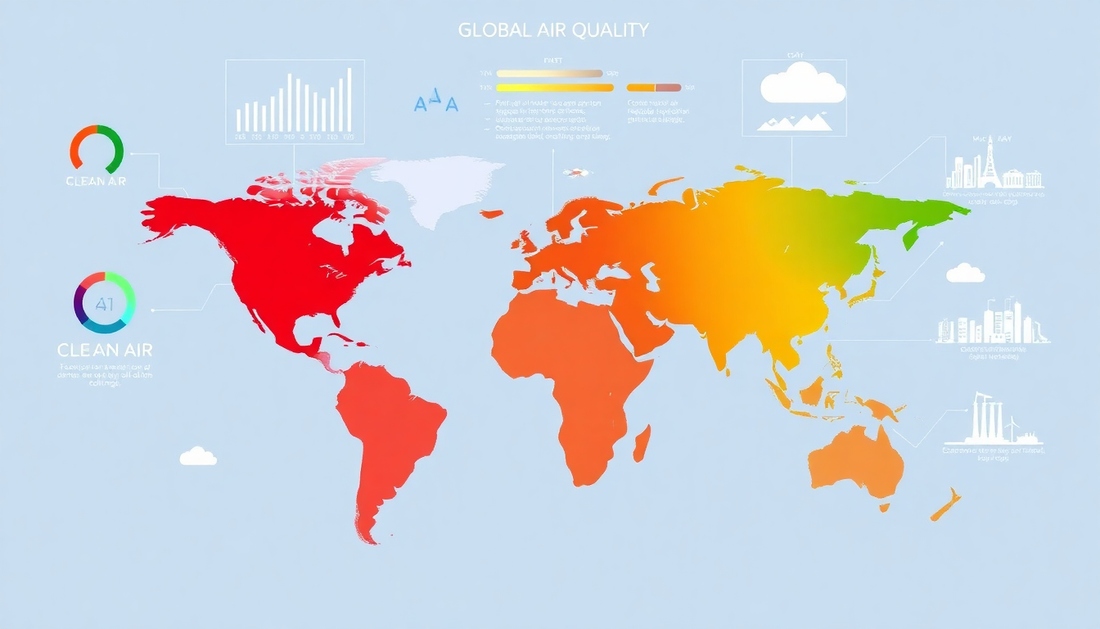In a world where the air we breathe has become a growing concern, the World Health Organization (WHO) has once again stepped up to the challenge, releasing a comprehensive report that sheds light on the global state of air quality. As we navigate the complexities of environmental protection and public health, this analysis delves into the key findings, implications, and recommendations outlined in the WHO's groundbreaking study.
Global Air Quality Challenges
The issue of air pollution is not a new one, but its scale and impact have continued to escalate in recent decades. From the bustling metropolises of the developing world to the picturesque rural landscapes, the invisible threat of air contaminants has become a global phenomenon. The WHO's report paints a sobering picture, highlighting the widespread prevalence of harmful pollutants and their detrimental effects on human health and the environment.
Importance of WHO Guidelines
The WHO's air quality guidelines have long served as the gold standard for policymakers, public health officials, and environmental advocates. These evidence-based recommendations provide a roadmap for governments and communities to address the pressing challenges of air pollution. By setting clear targets and outlining best practices, the WHO empowers nations to take decisive action and safeguard the well-being of their citizens.
Purpose of the Comprehensive Report
The latest WHO air quality report represents a landmark achievement, offering a comprehensive analysis of the current state of global air quality. Drawing on extensive data from monitoring stations around the world, the report delves into the nuances of pollutant concentrations, regional variations, and the far-reaching health implications. This in-depth examination serves as a critical resource for policymakers, public health professionals, and the general public, equipping them with the knowledge to drive meaningful change.
Worldwide Air Pollution Trends
The WHO's findings paint a sobering picture of the global air quality landscape. Despite some localized improvements, the overall trend remains concerning, with many regions continuing to grapple with dangerously high levels of air pollutants. From the smog-choked cities of Asia to the industrial heartlands of Europe, the report highlights the widespread nature of this environmental crisis.
Regional Variations
While air pollution is a global challenge, the report underscores the significant regional variations in air quality. Factors such as economic development, energy sources, and urban planning contribute to these disparities, with some regions faring better than others. Understanding these regional nuances is crucial for tailoring effective interventions and addressing the unique challenges faced by different communities.
Health Impact Statistics
The WHO's report leaves no doubt about the profound impact of air pollution on human health. The data paints a stark picture, linking poor air quality to a range of respiratory diseases, cardiovascular complications, and even premature mortality. These alarming statistics serve as a wake-up call, underscoring the urgent need for comprehensive action to safeguard public health.
Historical Context of WHO Guidelines
The WHO's air quality guidelines have a long and storied history, evolving alongside our understanding of the complex relationship between the environment and human health. The report traces the development of these guidelines, highlighting how they have adapted to incorporate the latest scientific evidence and address emerging challenges.
Latest Recommendations
The WHO's latest air quality guidelines represent a significant milestone, reflecting the organization's commitment to evidence-based policymaking. The report outlines the updated recommendations, which provide more stringent targets for key pollutants, such as particulate matter, nitrogen dioxide, and ozone. These guidelines serve as a roadmap for governments and communities to prioritize air quality improvement efforts.
Measurement Methodologies
Accurate measurement and monitoring of air pollutants are essential for informed decision-making and effective interventions. The WHO report delves into the various methodologies employed in air quality monitoring, ensuring transparency and consistency in data collection and analysis. This emphasis on rigorous measurement techniques underscores the organization's commitment to evidence-based policymaking.
Particulate Matter
Particulate matter, or PM, is a primary focus of the WHO's air quality guidelines. The report examines the different size fractions of PM, their sources, and their respective health impacts. From the microscopic PM2.5 particles to the larger PM10 pollutants, the report provides a comprehensive understanding of this ubiquitous and dangerous class of air contaminants.
Nitrogen Dioxide
Nitrogen dioxide (NO2) is another pollutant that has garnered significant attention in the WHO's report. Emitted primarily from the combustion of fossil fuels, NO2 can have far-reaching consequences for respiratory health and environmental quality. The report delves into the latest research on the effects of NO2 exposure and the strategies for mitigating its presence in the air.
Sulfur Dioxide
Sulfur dioxide (SO2) is a pollutant that has historically been associated with industrial activities and power generation. The WHO's report examines the current trends in SO2 levels, the health risks it poses, and the measures being taken to reduce its presence in the atmosphere.
Ozone
Ground-level ozone is a complex and often overlooked air pollutant. The WHO's report sheds light on the formation of ozone, its sources, and its detrimental effects on human health and the environment. By addressing this pervasive issue, the report provides a comprehensive framework for addressing the multifaceted challenges of air quality.
Respiratory Diseases
The link between air pollution and respiratory health is well-established, and the WHO's report delves into the specifics of this relationship. From the exacerbation of asthma to the increased risk of lung cancer, the report highlights the profound impact of air contaminants on the respiratory system.
Cardiovascular Risks
Air pollution's influence extends beyond the respiratory system, with the report also addressing its connection to cardiovascular diseases. The data reveals a troubling correlation between exposure to air pollutants and an increased risk of heart attacks, strokes, and other cardiovascular complications.
Long-term Population Health Consequences
The report's analysis goes beyond the immediate health effects, examining the long-term implications of air pollution on population health. From the increased burden on healthcare systems to the socioeconomic impacts, the report paints a sobering picture of the far-reaching consequences of poor air quality.
Monitoring Systems
Effective air quality monitoring is a crucial component of the WHO's recommendations. The report delves into the various technological advancements and best practices in monitoring systems, empowering communities to track and respond to air pollution in real-time.
Governmental Regulations
The WHO's report emphasizes the critical role of governmental regulations in addressing air quality challenges. From emission standards to urban planning policies, the report highlights the need for comprehensive, evidence-based policymaking to drive meaningful change.
Sustainable Urban Planning
The report also underscores the importance of sustainable urban planning in mitigating air pollution. By incorporating green spaces, promoting public transportation, and prioritizing energy-efficient infrastructure, cities can create healthier, more livable environments for their residents.
Emerging Technologies
The report looks to the future, exploring the potential of emerging technologies to revolutionize air quality management. From advanced sensor networks to innovative clean energy solutions, the report provides a glimpse into the promising innovations that could shape the path towards a cleaner, healthier future.
Global Cooperation Strategies
Recognizing the transnational nature of air pollution, the WHO's report emphasizes the need for global cooperation and coordination. By fostering international partnerships, sharing best practices, and aligning policies, the report outlines a roadmap for collective action to address this pressing environmental challenge.
Individual and Community Actions
While governmental and institutional efforts are crucial, the report also highlights the pivotal role of individual and community-level actions in improving air quality. From adopting sustainable lifestyle choices to advocating for local policy changes, the report empowers citizens to become active participants in the fight for cleaner air.
Conclusion
The WHO's latest air quality report stands as a testament to the organization's unwavering commitment to global public health. By providing a comprehensive analysis of the current state of air quality, the report serves as a clarion call for urgent action. As we navigate the complexities of environmental protection and sustainable development, this landmark study offers a roadmap for policymakers, public health professionals, and concerned citizens to work towards a future where the air we breathe is clean, safe, and life-sustaining. The time for action is now, and the WHO's report provides the necessary impetus to drive meaningful change and secure a healthier, more resilient world for generations to come.

